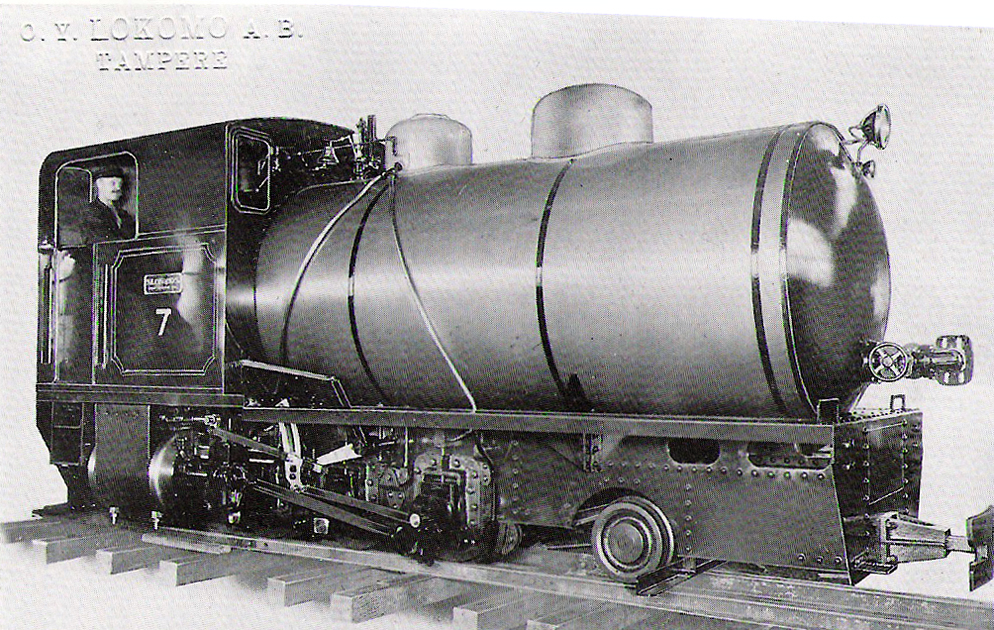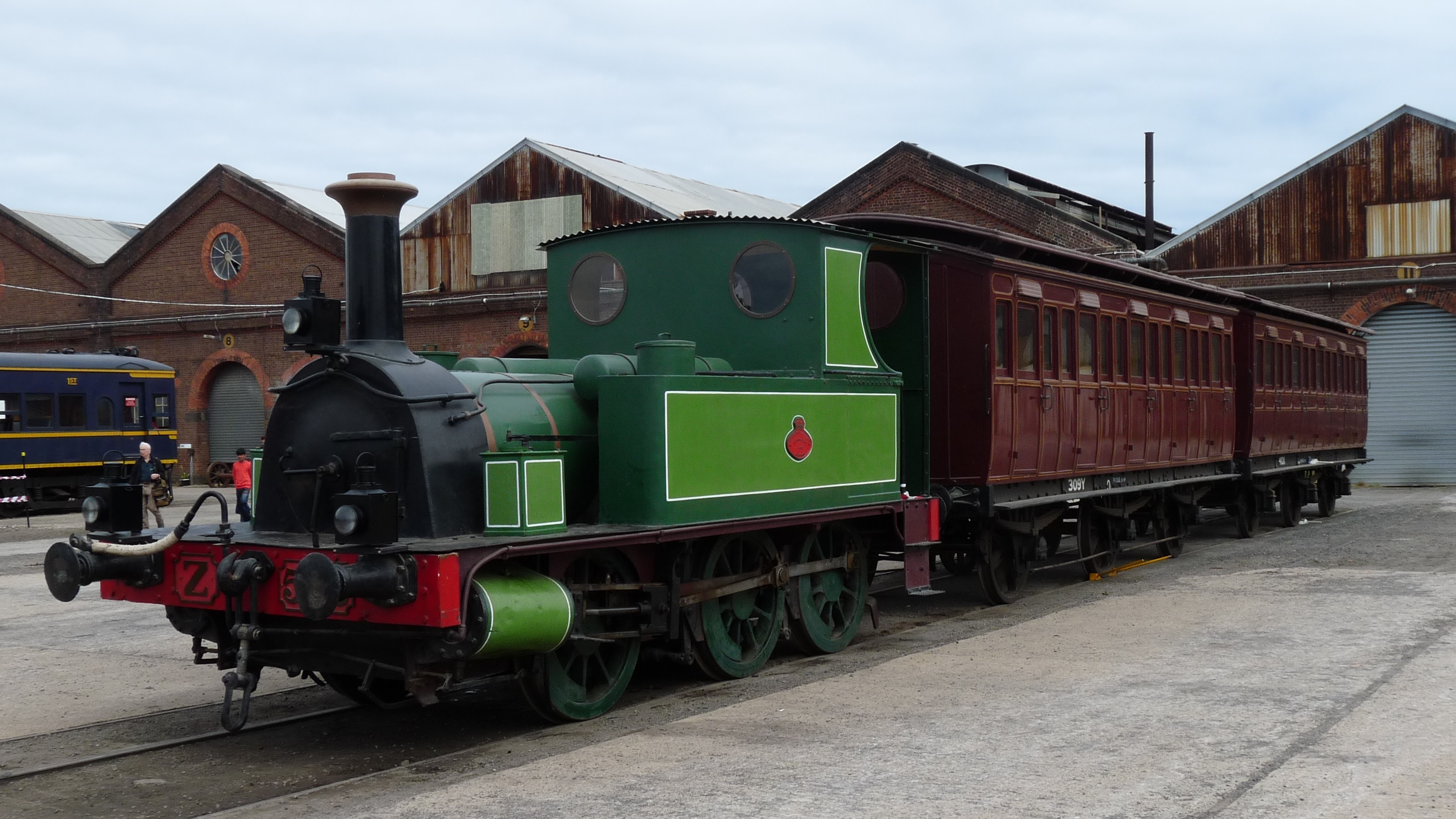|
Fireless Locomotive
A fireless locomotive is a type of locomotive which uses reciprocating engines powered from a reservoir of compressed air or steam, which is filled at intervals from an external source. They offer advantages over conventional steam locomotives of lower cost per unit, cleanliness, and decreased risk from fire or boiler explosion; these are counterbalanced by the need for a source to refill the locomotive, and by the limited range afforded by the reservoir. They were desirable in situations where smoke from a firebox would be too noxious, or where there was risk of fire or explosion. Typical usage was in a mine, or a food or chemical factory. They were also used where a source of air or steam was readily available, and for moving loads within limited areas, such as a switch yard or within an industrial factory. They were eventually replaced for most uses by diesel and battery electric locomotives fitted with protective appliances; these are described as flame-proof locomotives. ... [...More Info...] [...Related Items...] OR: [Wikipedia] [Google] [Baidu] |
Ammonia
Ammonia is an inorganic chemical compound of nitrogen and hydrogen with the chemical formula, formula . A Binary compounds of hydrogen, stable binary hydride and the simplest pnictogen hydride, ammonia is a colourless gas with a distinctive pungent smell. It is widely used in fertilizers, refrigerants, explosives, cleaning agents, and is a precursor for numeous chemicals. Biologically, it is a common nitrogenous waste, and it contributes significantly to the nutritional needs of terrestrial organisms by serving as a precursor to fertilisers. Around 70% of ammonia produced industrially is used to make fertilisers in various forms and composition, such as urea and diammonium phosphate. Ammonia in pure form is also applied directly into the soil. Ammonia, either directly or indirectly, is also a building block for the synthesis of many chemicals. In many countries, it is classified as an List of extremely hazardous substances, extremely hazardous substance. Ammonia is toxic, cau ... [...More Info...] [...Related Items...] OR: [Wikipedia] [Google] [Baidu] |
Boiler
A boiler is a closed vessel in which fluid (generally water) is heated. The fluid does not necessarily boil. The heated or vaporized fluid exits the boiler for use in various processes or heating applications, including water heating, central heating, boiler-based power generation, cooking, and sanitation. Heat sources In a fossil fuel power plant using a steam cycle for power generation, the primary heat source will be combustion of coal, oil, or natural gas. In some cases byproduct fuel such as the carbon monoxide rich offgasses of a coke battery can be burned to heat a boiler; biofuels such as bagasse, where economically available, can also be used. In a nuclear power plant, boilers called steam generators are heated by the heat produced by nuclear fission. Where a large volume of hot gas is available from some process, a heat recovery steam generator or recovery boiler can use the heat to produce steam, with little or no extra fuel consumed; such a configuration is ... [...More Info...] [...Related Items...] OR: [Wikipedia] [Google] [Baidu] |
Steam Accumulator
Steam is water vapor, often mixed with air or an aerosol of liquid water droplets. This may occur due to evaporation or due to boiling, where heat is applied until water reaches the enthalpy of vaporization. Saturated or superheated steam is invisible; however, wet steam, a visible mist or aerosol of water droplets, is often referred to as "steam". When liquid water becomes steam, it increases in volume by 1,700 times at standard temperature and pressure; this change in volume can be converted into mechanical work by steam engines such as reciprocating piston type engines and steam turbines, which are a sub-group of steam engines. Piston type steam engines played a central role in the Industrial Revolution and modern steam turbines are used to generate more than 80% of the world's electricity. If liquid water comes in contact with a very hot surface or depressurizes quickly below its vapour pressure, it can create a steam explosion. Types of steam and conversions Steam ... [...More Info...] [...Related Items...] OR: [Wikipedia] [Google] [Baidu] |
Mannheim
Mannheim (; Palatine German language, Palatine German: or ), officially the University City of Mannheim (), is the List of cities in Baden-Württemberg by population, second-largest city in Baden-Württemberg after Stuttgart, the States of Germany, state capital, and Germany's List of cities in Germany by population, 21st-largest city, with a population of over 315,000. It is located at the border with Rhineland-Palatinate. The city is the cultural and economic centre of the Rhine-Neckar, Germany's Metropolitan regions in Germany, seventh-largest metropolitan region, with nearly 2.4 million inhabitants. Mannheim is located at the confluence of the Upper Rhine and the Neckar in the Kurpfalz (region), Kurpfalz (Electoral Palatinate) region of northwestern Baden-Württemberg. The city lies in the Upper Rhine Plain, Germany's warmest region, between the Palatine Forest and the Oden Forest. Mannheim forms a continuous urban zone of around 500,000 inhabitants with Ludwigshafen am Rhe ... [...More Info...] [...Related Items...] OR: [Wikipedia] [Google] [Baidu] |
Heisler Locomotive
The Heisler locomotive is one of the three major types of geared steam locomotives and the last to be patented. Charles L. Heisler received a patent for the design in 1892, following the construction of a prototype in 1891. Somewhat similar to a Climax locomotive, Heisler's design featured two cylinders canted inwards at a 45-degree angle to form a 'V-twin' arrangement. Power then went to a longitudinal drive shaft in the center of the frame that drove the outboard axle on each powered truck through bevel gears in an enclosed gearcase riding on the axle between the truck frames. The inboard axle on each truck was then driven from the outboard one by external side (connecting) rods. In 1897, Heisler received a patent on a three-truck locomotive.Charles L. Heisler, LocomotiveU.S. Patent 585,031 June 22, 1897. As with Class C Shay locomotives, the tender rode on the third truck. Unlike the Shay, Heisler's design did not have a continuous string of line shafting running the lengt ... [...More Info...] [...Related Items...] OR: [Wikipedia] [Google] [Baidu] |
0-8-0
Under the Whyte notation for the classification of steam locomotives, represents the wheel arrangement of no leading wheels, eight powered and coupled driving wheels on four axles and no trailing wheels. Locomotives of this type are also referred to as eight coupled. Overview Examples of the 0-8-0 wheel arrangement were constructed both as tender locomotive, tender and tank locomotives. The earliest locomotives were built for mainline haulage, particularly for Freight rail transport, freight, but the configuration was later also often used for large switcher locomotives (shunter locomotives). The wheel arrangement provided a powerful layout with all engine weight as adhesive weight, which maximised the tractive effort and factor of adhesion. The layout was generally too large for smaller and lighter railways, where the more popular wheel arrangement would often be found performing similar duties. Usage Austria Two 0-8-0 locomotives were delivered from Elsässische Maschinenbau ... [...More Info...] [...Related Items...] OR: [Wikipedia] [Google] [Baidu] |
0-6-0
is the Whyte notation designation for steam locomotives with a wheel arrangement of no leading wheels, six powered and coupled driving wheels on three axles, and no trailing wheels. Historically, this was the most common wheel arrangement used on both Tender (rail), tender and tank locomotives in versions with both Cylinder (locomotive), inside and outside cylinders. In the United Kingdom, the Whyte notation of wheel arrangement was also often used for the classification of electric and diesel-electric locomotives with side-rod coupled driving wheels. Under the UIC classification, popular in Europe, this wheel arrangement is written as C if the wheels are coupled with rods or gears, or Co if they are independently driven, the latter usually being electric and diesel-electric locomotives. Overview History The 0-6-0 configuration was the most widely used wheel arrangement for both Tender (rail), tender and tank locomotive, tank steam locomotives. The type was also widely used fo ... [...More Info...] [...Related Items...] OR: [Wikipedia] [Google] [Baidu] |
0-4-0
Under the Whyte notation for the classification of steam locomotives, represents one of the simplest possible types, that with two axles and four coupled wheels, all of which are driven. The wheels on the earliest four-coupled locomotives were connected by a single gear wheel, but from 1825 the wheels were usually connected with coupling rods to form a single driven set. The notation 0-4-0T indicates a tank locomotive of this wheel arrangement on which its water and fuel is carried on board the engine itself, rather than in an attached tender. In Britain, the Whyte notation of wheel arrangement was also often used for the classification of electric and diesel-electric locomotives with side-rod-coupled driving wheels. Under the UIC classification used in Europe and, in more recent years, in simplified form in the United States, a 0-4-0 is classified as B (German and Italian) if the axles are connected by side rods or gearing and 020 (French), independent of axle motoring. ... [...More Info...] [...Related Items...] OR: [Wikipedia] [Google] [Baidu] |
Switcher Locomotive
A switcher locomotive (American English), shunter locomotive (British English), station pilot (British English), or shifter locomotive (Pennsylvania Railroad terminology) is a locomotive used for maneuvering railway vehicles over short distances. Switchers do not usually move train A train (from Old French , from Latin">-4; we might wonder whether there's a point at which it's appropriate to talk of the beginnings of French, that is, when it wa ... , from Latin , "to pull, to draw") is a series of connected vehicles th ...s over long distances. Instead, they typically assemble trains in order for another locomotive to take over. Switchers often operate in a railyard or make short transfer runs. They may serve as the primary motive power on short branch lines or switching and terminal railroads. A hybrid type known as a road switcher can both shunt and haul trains. Switchers are optimized for their role, being relatively low-powered but with a high starting tractive eff ... [...More Info...] [...Related Items...] OR: [Wikipedia] [Google] [Baidu] |







